2012 VOLKSWAGEN TRANSPORTER warning
[x] Cancel search: warningPage 386 of 486
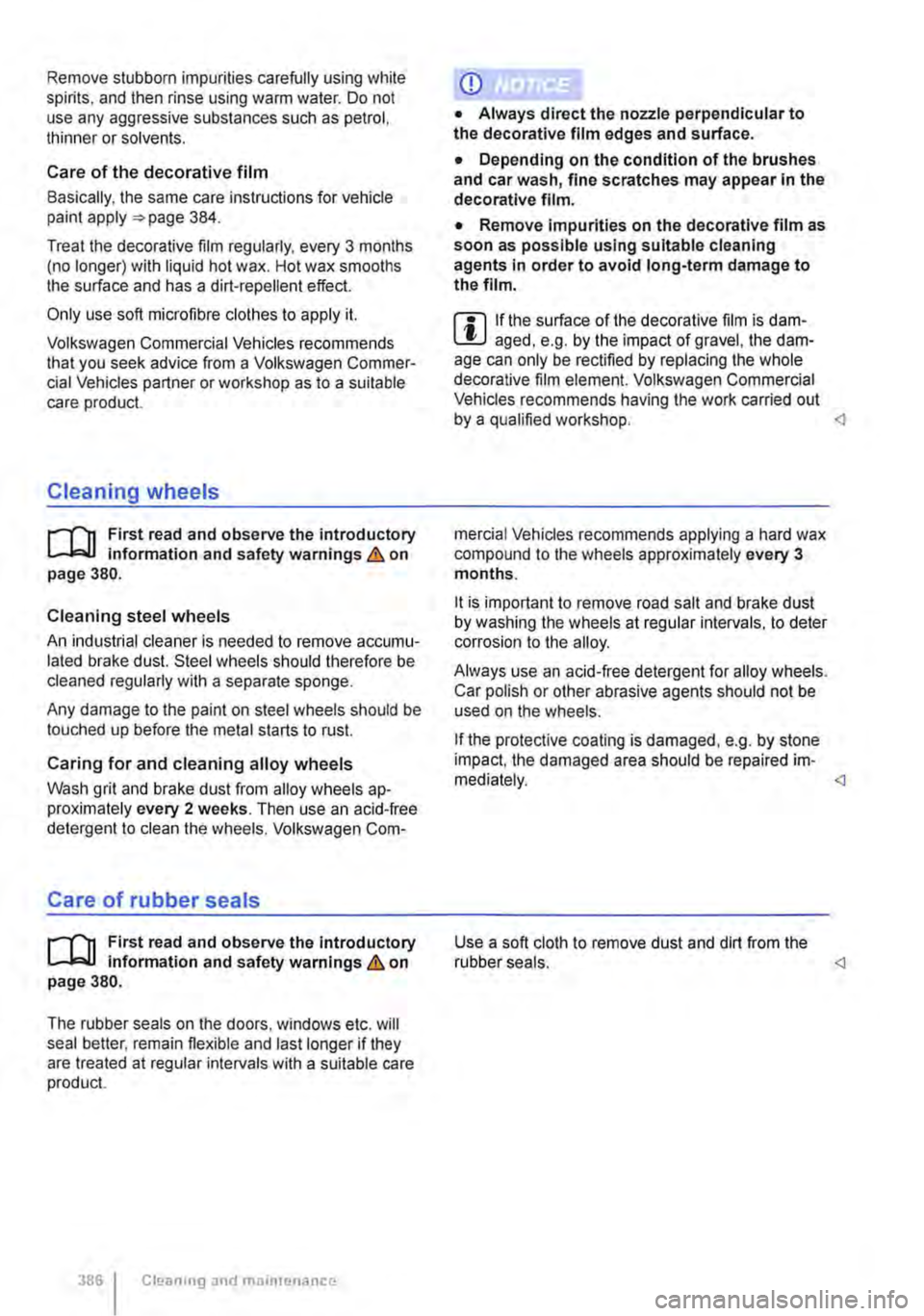
Remove stubborn impurities carefully using white spirits. and then rinse using warm water. Do not use any aggressive substances such as petrol, thinner or solvents.
Care of the decorative film
Basically, the same care instructions for vehicle paint apply =>page 384.
Treat the decorative film regularly, every 3 months (no longer) with liquid hot wax. Hot wax smooths the surface and has a dirt-repellent effect.
Only use soft microfibre clothes to apply it.
Volkswagen Commercial Vehicles recommends that you seek advice from a Volkswagen Commer-cial Vehicles partner or workshop as to a suitable care product.
Cleaning wheels
rill First read and observe the introductory information and safety warnings & on page 380.
Cleaning steel wheels
An industrial cleaner is needed to remove accumu-lated brake dust. Steel wheels should therefore be cleaned regularly with a separate sponge.
Any damage to the paint on steel wheels should be touched up before the metal starts to rust.
Caring for and cleaning alloy wheels
Wash grit and brake dust from alloy wheels ap-proximately every 2 weeks. Then use an acid-free detergent to clean the wheels. Volkswagen Corn-
Care of rubber seals
rill First read and observe the Introductory Information and safety warnings & on page 380.
The rubber seals on the doors, windows etc. will seal better, remain flexible and last longer if they are treated at regular intervals with a suitable care product.
386 Cleanmg and maintenance
• Depending on the condition of the brushes and car wash, fine scratches may appear In the decorative film.
• Remove impurities on the decorative film as soon as possible using suitable cleaning agents in order to avoid long-term damage to the film.
r::l If the surface of the decorative film is dam-L!.J aged, e.g. by the impact of gravel, the dam-age can only be rectified by replacing the whole decorative film element. Volkswagen Commercial Vehicles recommends having the work carried out by a qualified workshop.
it is important to remove road salt and brake dust by washing the wheels at regular intervals, to deter corrosion to the alloy.
Always use an acid-free detergent for alloy wheels. Car polish or other abrasive agents should not be used on the wheels.
If the protective coating is damaged, e.g. by stone impact, the damaged area should be repaired im-mediately.
Page 387 of 486
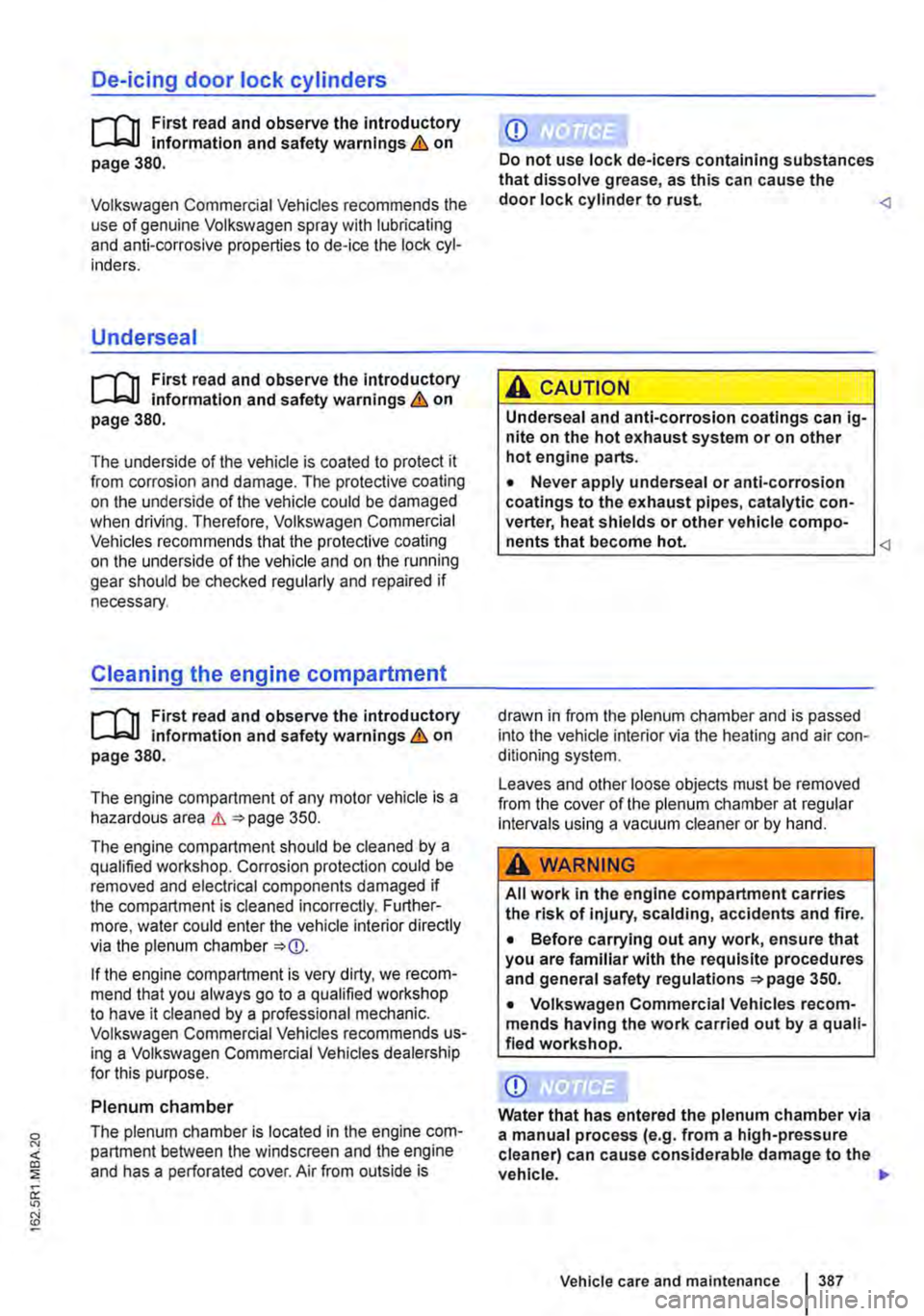
De-icing door lock cylinders
....-m First read and observe the introductory L-I=JJ information and safety warnings & on page 380.
Volkswagen Commercial Vehicles recommends the use of genuine Volkswagen spray with lubricating and anti-corrosive properties to de-ice the lock cyl-inders.
Undersea I
....-m First read and observe the introductory L-I=JJ information and safety warnings & on page 380.
The underside of the vehicle is coated to protect it from corrosion and damage. The protective coating on the underside of the vehicle could be damaged when driving. Therefore, Volkswagen Commercial Vehicles recommends that the protective coating on the underside of the vehicle and on the running gear should be checked regularly and repaired if necessary.
Cleaning the engine compartment
....-m First read and observe the introductory L-I=JJ information and safety warnings & on page 380.
The engine compartment of any motor vehicle is a hazardous area L1l. 350.
The engine compartment should be cleaned by a qualified workshop. Corrosion protection could be removed and electrical components damaged if the compartment is cleaned incorrectly. Further-more, water could enter the vehicle interior directly via the plenum chamber
If the engine compartment is very dirty, we recom-mend that you always go to a qualified workshop to have it cleaned by a professional mechanic. Volkswagen Commercial Vehicles recommends us-ing a Volkswagen Commercial Vehicles dealership for this purpose.
Plenum chamber
The plenum chamber is located in the engine com-partment between the windscreen and the engine and has a perforated cover. Air from outside is
CD·
Do not use lock de-leers containing substances that dissolve grease, as this can cause the door lock cylinder to rust.
Undersea! and anti-corrosion coatings can ig-nite on the hot exhaust system or on other hot engine parts.
• Never apply undersea! or anti-corrosion coatings to the exhaust pipes, catalytic con-verter, heat shields or other vehicle compo-nents that become hot.
Leaves and other loose objects must be removed from the cover of the plenum chamber at regular intervals using a vacuum cleaner or by hand.
A WARNING
All work in the engine compartment carries the risk of injury, scalding, accidents and fire.
• Before carrying out any work, ensure that you are familiar with the requisite procedures and general safety regulations 350.
• Volkswagen Commercial Vehicles recom-mends having the work carried out by a quali-fied workshop.
CD
Water that has entered the plenum chamber via a manual process (e.g. from a high-pressure cleaner) can cause considerable damage to the
vehicle. "'
Vehicle care and maintenance I 387
Page 388 of 486
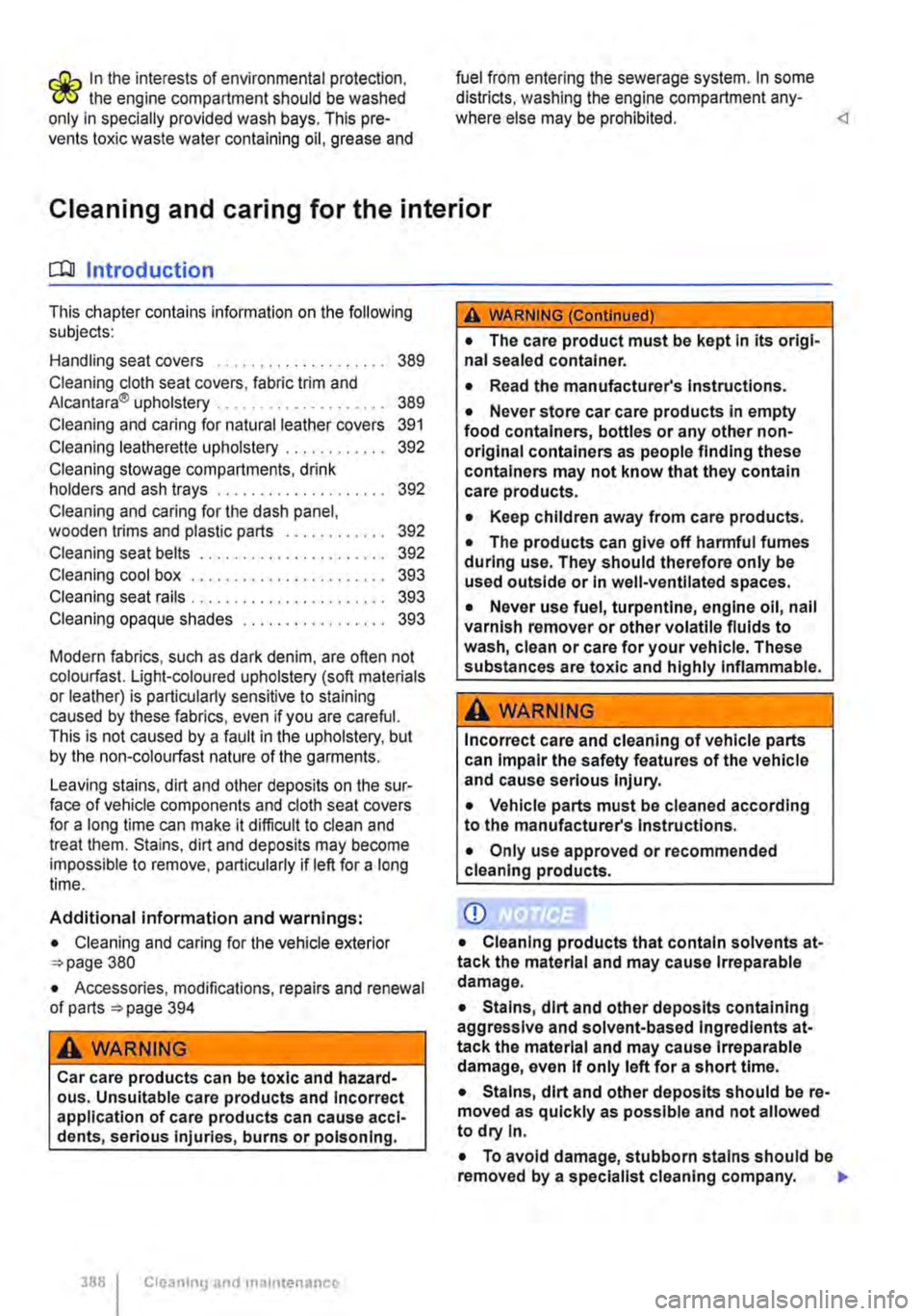
r1ih In the interests of environmental protection, 'r!!S the engine compartment should be washed only in specially provided wash bays. This pre-vents toxic waste water containing oil, grease and
fuel from entering the sewerage system. In some districts, washing the engine compartment any-where else may be prohibited.
o::JJ Introduction
This chapter contains information on the following subjects:
Handling seat covers . . . . . . . . . . . . . . . . . . . . 389
Cleaning cloth seat covers, fabric trim and Alcantara® upholstery . . . . . . . . . . . . . . . . . . . . 389
Cleaning and caring for natural leather covers 391
Cleaning leatherette upholstery . . 392
Cleaning stowage compartments, drink holders and ash trays . . . . . . . . . . . . . . . . . . . . 392 Cleaning and caring for the dash panel, wooden trims and plastic parts . . . . . . . . . . 392
Cleaning seat belts . . . . . . . . . . . . . . . . . . . . . . 392 Cleaning cool box . . . . . . . . . . . . . • . . . . . . . . . 393
Cleaning seat rails . . . . . . . . . . . . . . . . . . . 393
Cleaning opaque shades 393
Modern fabrics, such as dark denim, are often not colourfast. Light-coloured upholstery (soft materials or leather) is particularly sensitive to staining caused by these fabrics, even if you are careful. This is not caused by a fault in the upholstery, but by the non-colourfast nature of the garments.
Leaving stains, dirt and other deposits on the sur-face of vehicle components and cloth seat covers for a long time can make it difficult to clean and treat them. Stains, dirt and deposits may become impossible to remove, particularly if left for a long time.
Additional information and warnings:
• Cleaning and caring for the vehicle exterior 380
• Accessories, modifications, repairs and renewal of parts 394
A WARNING
Car care products can be toxic and hazard-ous. Unsuitable care products and Incorrect application of care products can cause acci-dents, serious injuries, burns or poisoning.
388 Cleaning and maintenance
A WARNING (Continued)
• The care product must be kept In its origi-nal sealed container.
• Read the manufacturer's Instructions.
• Never store car care products in empty food containers, bottles or any other non-original containers as people finding these containers may not know that they contain care products.
• Keep children away from care products.
• The products can give off harmful fumes during use. They should therefore only be used outside or In well-ventilated spaces.
• Never use fuel, turpentine, engine oil, nail varnish remover or other volatile fluids to wash, clean or care for your vehicle. These substances are toxic and highly Inflammable.
A WARNING
Incorrect care and cleaning of vehicle parts can Impair the safety features of the vehicle and cause serious Injury.
• Vehicle parts must be cleaned according to the manufacturer's Instructions.
• Only use approved or recommended cleaning products.
CD
• Cleaning products that contain solvents at-tack the material and may cause Irreparable damage.
• Stains, dirt and other deposits containing aggressive and solvent-based Ingredients at-tack the material and may cause Irreparable damage, even If only left for a short time.
• Stains, dirt and other deposits should be re-moved as quickly as possible and not allowed to dry In.
• To avoid damage, stubborn stains should be removed by a specialist cleaning company, .,.
Page 389 of 486
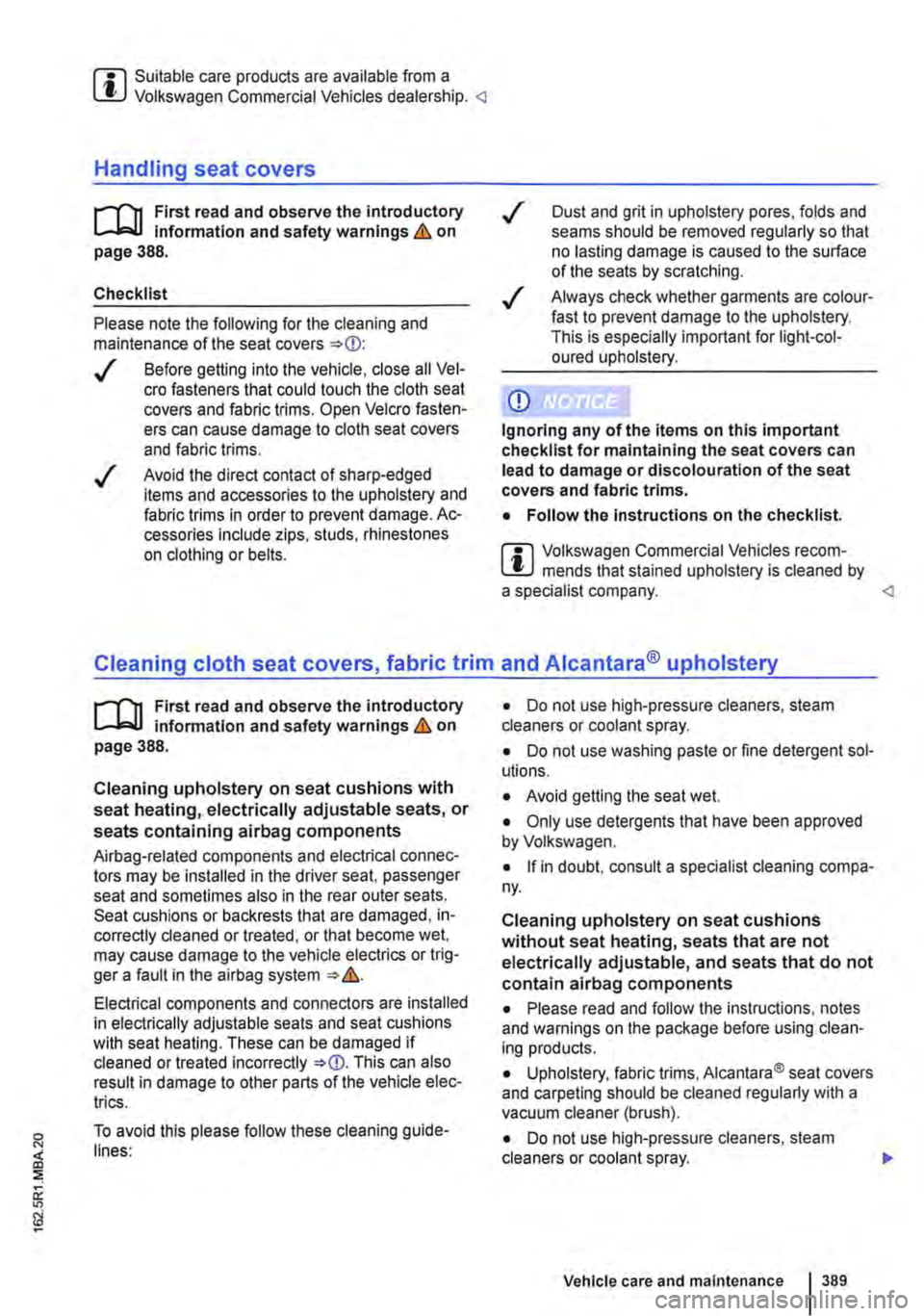
m Suitable care products are available from a W Volkswagen Commercial Vehicles dealership.
r--f'n First read and observe the introductory L-J,::.U Information and safety warnings & on page 388.
Checklist
Please note the following for the cleaning and maintenance of the seat covers =>Q):
v' Before getting into the vehicle, close all Vel-era fasteners that could touch the cloth seat covers and fabric trims. Open Velcro fasten-ers can cause damage to cloth seat covers and fabric trims.
v' Avoid the direct contact of sharp-edged items and accessories to the upholstery and fabric trims in order to prevent damage. Ac-cessories include zips, studs, rhinestones on clothing or belts.
v' Dust and grit in upholstery pores, folds and seams should be removed regularly so that no lasting damage is caused to the surface of the seats by scratching.
v' Always check whether garments are colour-fast to prevent damage to the upholstery. This is especially important for light-col-oured upholstery.
CD
Ignoring any ofthe items on this important checklist for maintaining the seat covers can lead to damage or discolouration of the seat covers and fabric trims.
• Follow the Instructions on the checklist.
m Volkswagen Commercial Vehicles recom-l!.J mends that stained upholstery is cleaned by a specialist company.
r--f'n First read and observe the introductory L-J,::.IJ information and safety warnings & on page 388.
Cleaning upholstery on seat cushions with seat heating, electrically adjustable seats, or seats containing airbag components
Airbag-related components and electrical connec-tors may be installed in the driver seat, passenger seat and sometimes also in the rear outer seats. Seat cushions or backrests that are damaged, in-correctly cleaned or treated, or that become wet, may cause damage to the vehicle electrics or trig-ger a fault in the airbag system => &.
Electrical components and connectors are installed in electrically adjustable seats and seat cushions with seat heating. These can be damaged if cleaned or treated incorrectly =>Q). This can also result in damage to other parts of the vehicle elec-trics.
To avoid this please follow these cleaning guide-lines:
• Do not use high-pressure cleaners, steam cleaners or coolant spray.
• Do not use washing paste or fine detergent sol-utions.
• Avoid getting the seat wet.
• Only use detergents that have been approved by Volkswagen.
• If in doubt, consult a specialist cleaning compa-ny.
Cleaning upholstery on seat cushions without seat heating, seats that are not electrically adjustable, and seats that do not contain airbag components
• Please read and follow the instructions, notes and warnings on the package before using clean-ing products.
• Upholstery, fabric trims, Alcantara® seat covers and carpeting should be cleaned regularly with a vacuum cleaner (brush).
• Do not use high-pressure cleaners, steam cleaners or coolant spray.
Vehicle care and maintenance 389
Page 390 of 486
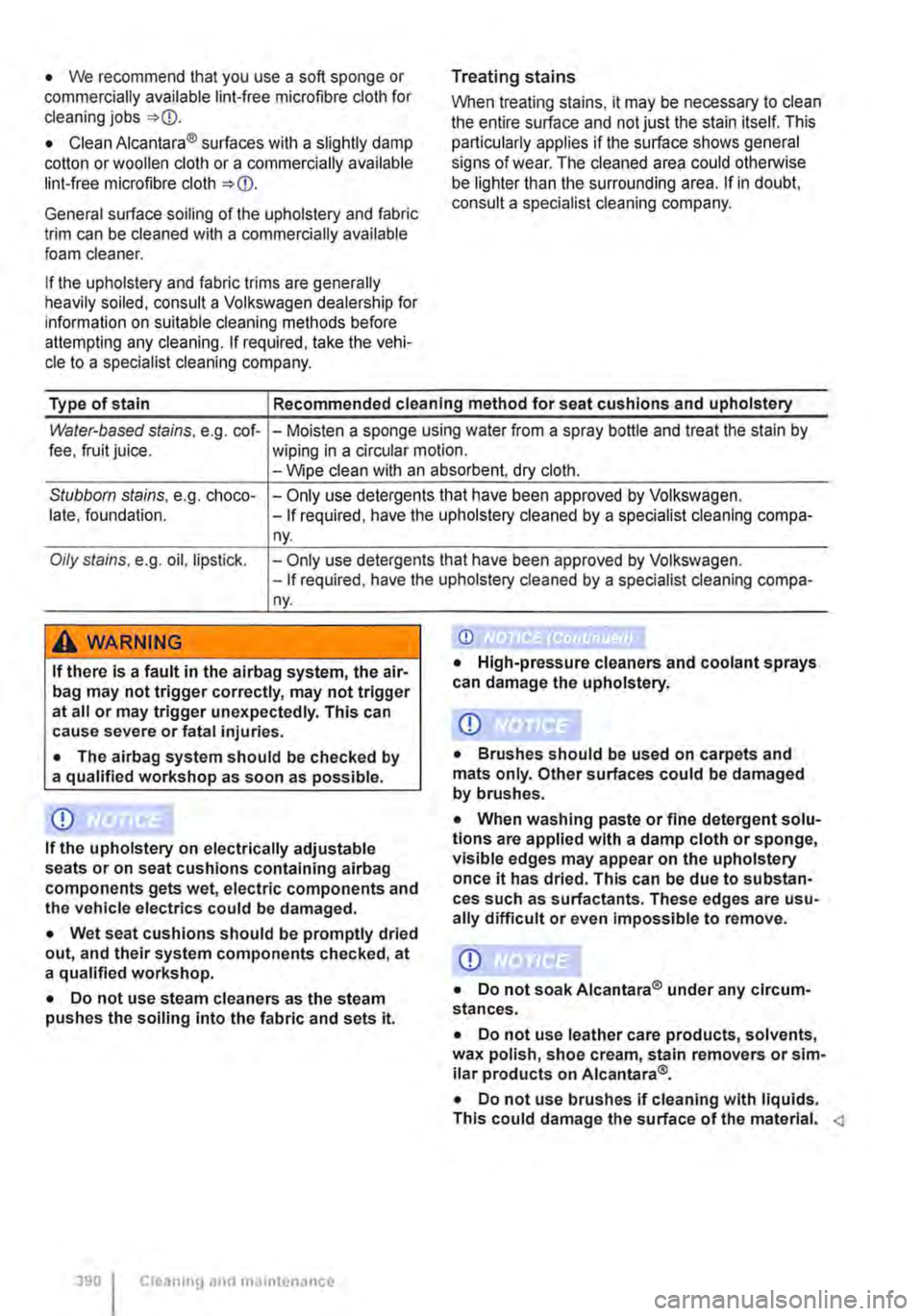
• We recommend that you use a soft sponge or commercially available lint-free microfibre cloth for cleaning jobs
• Clean Alcantara® surfaces with a slightly damp cotton or woollen cloth or a commercially available lint-free microfibre cloth
General surface soiling of the upholstery and fabric trim can be cleaned with a commercially available foam cleaner.
If the upholstery and fabric trims are generally heavily soiled, consult a Volkswagen dealership for information on suitable cleaning methods before attempting any cleaning. If required, take the vehi-cle to a specialist cleaning company.
Treating stains
When treating stains, it may be necessary to clean the entire surface and not just the stain itself. This particularly applies if the surface shows general signs of wear. The cleaned area could otherwise be lighter than the surrounding area. If in doubt, consult a specialist cleaning company.
Type of stain Recommended cleaning method for seat cushions and upholstery
Water-based stains, e.g. cof-fee, fruit juice. -Moisten a sponge using water from a spray bottle and treat the stain by wiping in a circular motion. -Wipe clean with an absorbent, dry cloth.
Stubborn stains, e.g. choco--Only use detergents that have been approved by Volkswagen. late, foundation. -If required, have the upholstery cleaned by a specialist cleaning compa-ny.
Oily stains, e.g. oil, lipstick. -Only use detergents that have been approved by Volkswagen. -If required, have the upholstery cleaned by a specialist cleaning compa-ny.
A WARNING CD
If there is a fault in the airbag system, the air-bag may not trigger correctly, may not trigger at all or may trigger unexpectedly. This can cause severe or fatal injuries.
• The airbag system should be checked by a qualified workshop as soon as possible.
Q)
If the upholstery on electrically adjustable seats or on seat cushions containing airbag components gets wet, electric components and the vehicle electrics could be damaged.
• Wet seat cushions should be promptly dried out, and their system components checked, at a qualified workshop.
• Do not use steam cleaners as the steam pushes the soiling into the fabric and sets it.
390 Cleaning and maintenance
• High-pressure cleaners and coolant sprays can damage the upholstery.
Q)
• Brushes should be used on carpets and mats only. Other surfaces could be damaged by brushes.
• When washing paste or fine detergent solu-tions are applied with a damp cloth or sponge, visible edges may appear on the upholstery once it has dried. This can be due to substan-ces such as surfactants. These edges are usu-ally difficult or even Impossible to remove.
Q)
• Do not soak Alcantara® under any circum-stances.
• Do not use leather care products, solvents, wax polish, shoe cream, stain removers or sim-ilar products on Alcantara®.
• Do not use brushes if cleaning with liquids. This could damage the surface of the material.
Page 391 of 486
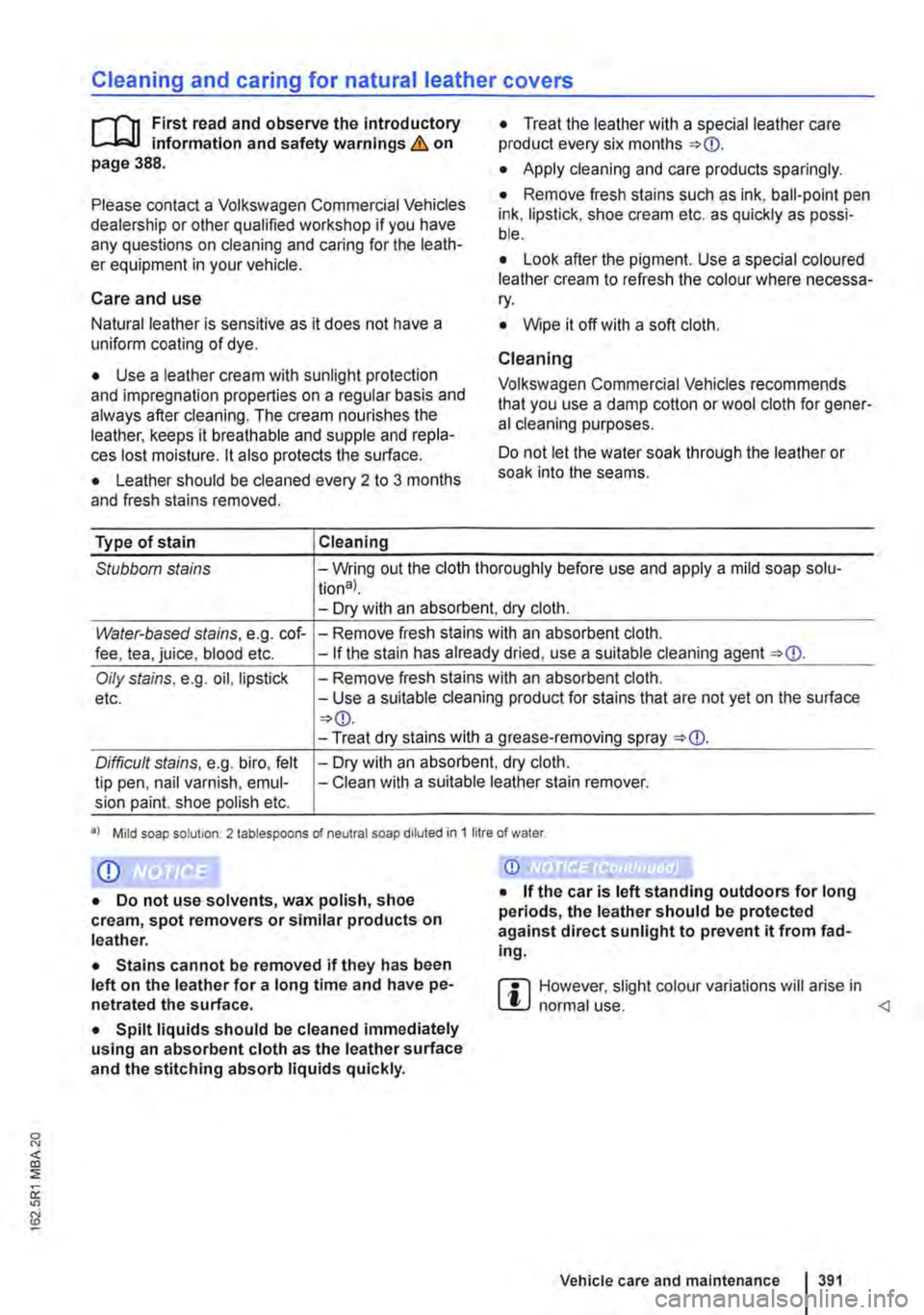
Cleaning and caring for natural leather covers
r-f"'n First read and observe the introductory L-.I.::.U information and safety warnings & on page 388.
Please contact a Volkswagen Commercial Vehicles dealership or other qualified workshop if you have any questions on cleaning and caring for the leath-er equipment in your vehicle.
Care and use
Natural leather is sensitive as it does not have a uniform coating of dye.
• Use a leather cream with sunlight protection and impregnation properties on a regular basis and always after cleaning. The cream nourishes the leather, keeps it breathable and supple and repla-ces lost moisture. lt also protects the surface.
• Leather should be cleaned every 2 to 3 months and fresh stains removed.
Type of stain Cleaning
• Treat the leather with a special leather care product every six months
• Apply cleaning and care products sparingly.
• Remove fresh stains such as ink, ball-point pen ink, lipstick, shoe cream etc. as quickly as possi-ble.
• Look after the pigment. Use a special coloured leather cream to refresh the colour where necessa-ry.
• Wipe it off with a soft cloth.
Cleaning
Volkswagen Commercial Vehicles recommends that you use a damp cotton or wool cloth for gener-al cleaning purposes.
Do not let the water soak through the leather or soak into the seams.
Stubborn stains -Wring out the cloth thoroughly before use and apply a mild soap solu-tional. -Dry with an absorbent, dry cloth.
Water-based stains, e.g. cof--Remove fresh stains with an absorbent cloth. fee, tea, juice, blood etc. -If the stain has already dried, use a suitable cleaning agent
Oily stains, e.g. oil, lipstick etc. -Remove fresh stains with an absorbent cloth. -Use a suitable cleaning product for stains that are not yet on the surface
-Treat dry stains with a grease-removing spray
Difficult stains, e.g. biro, felt tip pen, nail varnish, emul-sion paint. shoe polish etc.
-Dry with an absorbent, dry cloth. -Clean with a suitable leather stain remover.
•I Mild soap solut1on: 2 tablespoons of neutral soap diluted in 1 lilre of water
CD
• Do not use solvents, wax polish, shoe cream, spot removers or similar products on leather.
• Stains cannot be removed if they has been left on the leather for a long time and have pe-netrated the surface.
• Spilt liquids should be cleaned immediately using an absorbent cloth as the leather surface and the stitching absorb liquids quickly.
CD
• If the car is left standing outdoors for long periods, the leather should be protected against direct sunlight to prevent it from fad-Ing.
m However, slight colour variations will arise in W normal use.
Page 392 of 486
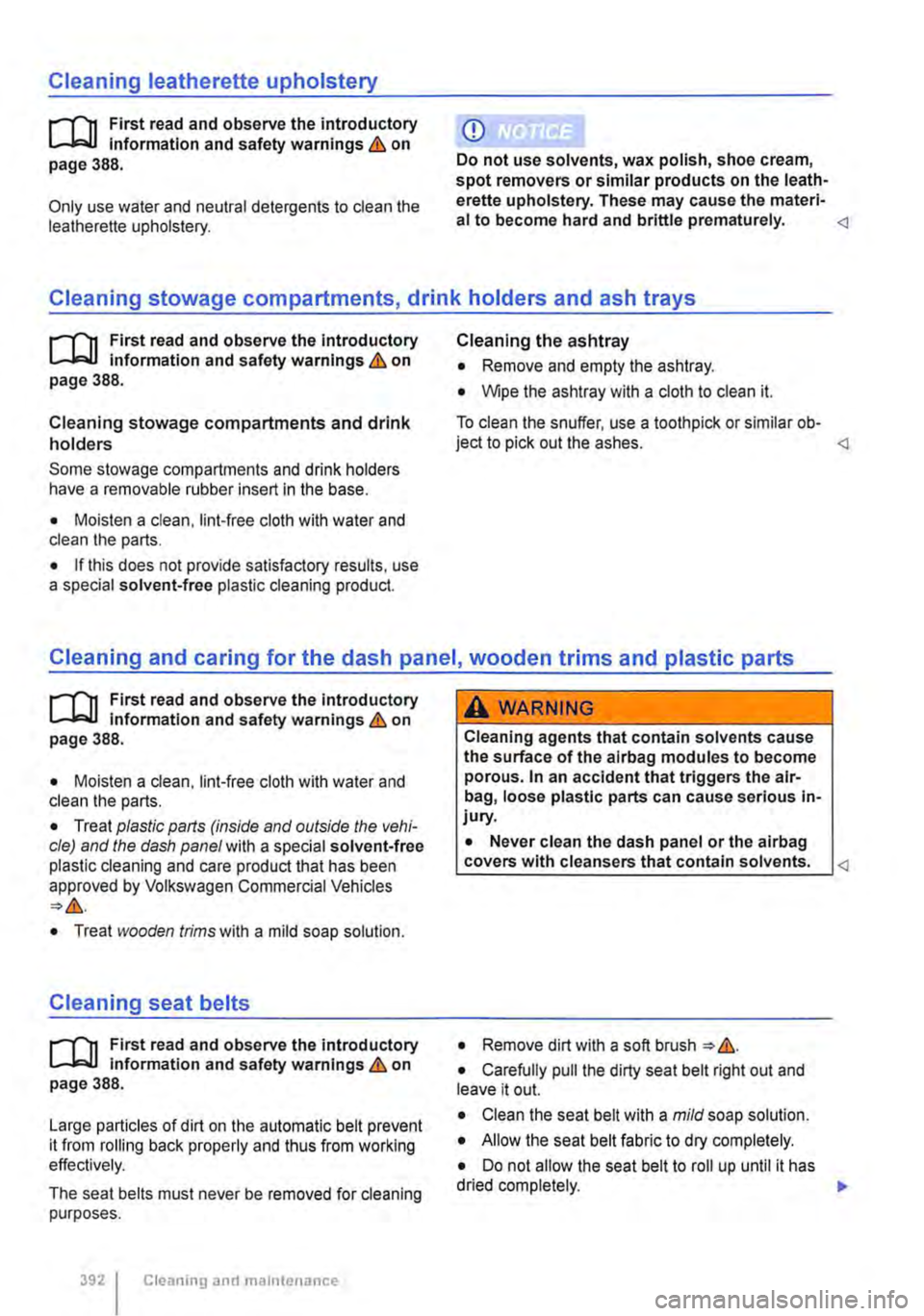
Cleaning leatherette upholstery
,......-('n First read and observe the introductory information and safety warnings & on page 388.
Only use water and neutral detergents to clean the ieatherette upholstery.
CD
Do not use solvents, wax polish, shoe cream, spot removers or similar products on the leath-erette upholstery. These may cause the materi-al to become hard and brittle prematurely.
,......-('n First read and observe the introductory information and safety warnings & on page 388.
Cleaning stowage compartments and drink holders
Some stowage compartments and drink holders have a removable rubber insert in the base.
• Moisten a clean, lint-free cloth with water and clean the parts.
• If this does not provide satisfactory results, use a special solvent-free plastic cleaning product.
Cleaning the ashtray
• Remove and empty the ashtray.
• Wipe the ashtray with a cloth to clean it.
To clean the snuffer, use a toothpick or similar ob-ject to pick out the ashes.
,......-('n First read and observe the introductory Information and safety warnings & on page 388.
• Moisten a clean, lint-free cloth with water and clean the parts.
• Treat plastic parts (inside and outside the vehi-cle) and the dash panel with a special solvent-free plastic cleaning and care product that has been approved by Volkswagen Commercial Vehicles
""'&.
• Treat wooden trims with a mild soap solution.
Cleaning seat belts
,......-('n First read and observe the introductory information and safety warnings & on page 388.
Large particles of dirt on the automatic belt prevent it from roiling back properly and thus from working effectively.
The seat belts must never be removed for cleaning purposes.
3921 Cleaning and maintenance
A WARNING
Cleaning agents that contain solvents cause the surface of the airbag modules to become porous. In an accident that triggers the air-bag, loose plastic parts can cause serious in-jury.
• Never clean the dash panel or the airbag covers with cleansers that contain solvents.
• Carefully pull the dirty seat belt right out and leave it out.
• Clean the seat belt with a mild soap solution.
• Allow the seat belt fabric to dry completely.
• Do not allow the seat belt to roil up until it has dried completely. 11>
Page 393 of 486
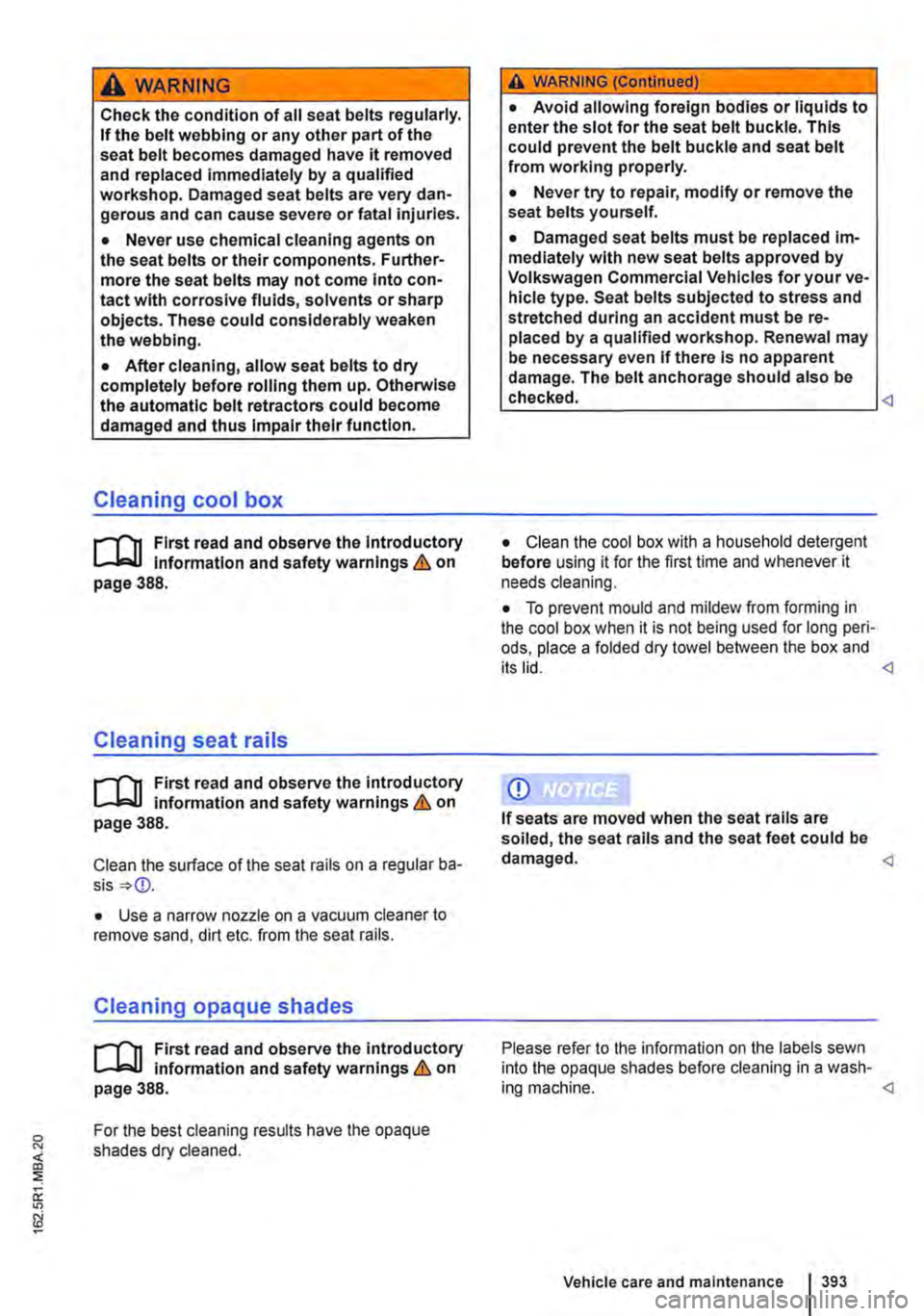
A wARNING
Check the condition of all seat belts regularly. If the belt webbing or any other part of the seat belt becomes damaged have it removed and replaced immediately by a qualified workshop. Damaged seat belts are very dan-gerous and can cause severe or fatal injuries.
• Never use chemical cleaning agents on the seat belts or their components. Further-more the seat belts may not come Into con-tact with corrosive fluids, solvents or sharp objects. These could considerably weaken the webbing.
• After cleaning, allow seat belts to dry completely before rolling them up. Otherwise the automatic belt retractors could become damaged and thus Impair their function.
Cleaning cool box
)""""'('n First read and observe the Introductory L.-J,:,JJ Information and safety warnings & on page 388.
Cleaning seat rails
)""""'('n First read and observe the introductory information and safety warnings & on page 388.
Clean the surface of the seat rails on a regular ba-sis
• Use a narrow nozzle on a vacuum cleaner to remove sand, dirt etc. from the seat rails.
Cleaning opaque shades
)""""'('n First read and observe the introductory information and safety warnings & on page 388.
For the best cleaning results have the opaque shades dry cleaned.
A WARNING (ConUnued)
• Avoid allowing foreign bodies or liquids to enter the slot for the seat belt buckle. This could prevent the belt buckle and seat belt from working properly.
• Never try to repair, modify or remove the seat belts yourself.
• Damaged seat belts must be replaced im-mediately with new seat belts approved by Volkswagen Commercial Vehicles for your ve-hicle type. Seat belts subjected to stress and stretched during an accident must be re-placed by a qualified workshop. Renewal may be necessary even if there is no apparent damage. The belt anchorage should also be checked.
• Clean the cool box with a household detergent before using it for the first time and whenever it needs cleaning.
• To prevent mould and mildew from forming in the cool box when it is not being used for long peri-ods, place a folded dry towel between the box and its lid.
CD
If seats are moved when the seat rails are soiled, the seat rails and the seat feet could be damaged.
Please refer to the information on the labels sewn into the opaque shades before cleaning in a wash-ing machine.
Vehicle care and maintenance 393